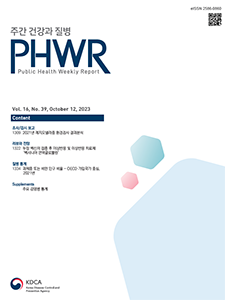Current Issue
Vol.16 No.39, October 12, 2023
-
Surveillance Reports 2023-10-12
 0
0
 946
946
 331
331
Environment Testing Results for Legionellosis in 2021
Gyehee Lee, Inho Kim, Jeongok Cha, Seulki Kang, Jin Gwack
Public Health Weekly Report 2023; 16(39): 1309-1321 https://doi.org/10.56786/PHWR.2023.16.39.1 Abstract
AbstractKorea Disease Control and Prevention Agency (KDCA) in charge of comprehensive management of environmental water facilities environment testing in various multi-use facilities to prevent Legionellosis in the Republic of Korea. In 2021, environment testing were planned for 3,956 facilities nationwide, but environment testing were carried out in 2,731 facilities (75.9%). An additional 395 facilities were tested compared to the 2,336 tested in 2020. The overall environment testing rate was 75.9%, with notably high environment testing rates observed in Ulsan (107.4%) and Sejong (100%). Based on the environment testing results reported through the national infectious diseases surveillance information system, Legionella species were detected in 447 facilities (16.4%) nationwide. Among multi-use facilities, hot springs, Korean sauna, tertiary hospitals, large public baths, and general hospitals exhibited detection rates higher than the overall. KDCA will continue to collaborate with relevant ministries and professional societies to manage Legionellosis in environmental facilities, including conducting a research project with The Society of Air-conditioning and Refrigerating Engineering of Korea in 2023 with the goal of identifying strategies to prevent and systematically manage Legionellosis and developing facility-specific legionella management guidelines.
-
Review & Perspective 2023-10-12
 0
0
 509
509
 141
141
Adverse Reactions after Smallpox Vaccination and Adverse Reaction Treatment by Vaccinia Immune Globulin
Sang Eun Lee, Jin-Won Kim, Hwajung Yi, Yoon-Seok Chung
Public Health Weekly Report 2023; 16(39): 1322-1333 https://doi.org/10.56786/PHWR.2023.16.39.2AbstractThe smallpox vaccine, which is based on vaccinia virus, has been effective in preventing this disease. Since the World Health Organization declared the eradication of smallpox in 1980, there has been no concern about the natural occurrence of smallpox, so vaccinations of the general population is not currently being conducted. However, as the variola virus is a pathogen that is possibly to be used in bioterrorism and is vaccinated against bioterrorism response personnel and people who may be exposed to the virus. These smallpox vaccines can cause local and minor adverse reactions, and in the case of the first and second generation smallpox vaccines, serious life-threatening complications may occur. Accordingly, vaccinia immune globulin (VIG) is used as a treatment for abnormal reactions caused by vaccination of the smallpox. However, since “VIG” is produced using the sera of people vaccinated against smallpox, the effectiveness and production between lots are variable, and demand may exceed supply. To compensate for these shortcomings, research and development of a smallpox vaccine side effect treatment that can be produced in various ways, based on human monoclonal antibodies with neutrality against the vaccinia virus and with standard effectiveness is underway.
-
QuickStats 2023-10-12
 0
0
 2366
2366
 267
267
Overweight or Obesity Rates in OECD Countries in 2021
Public Health Weekly Report 2023; 16(39): 1334-1335 https://doi.org/10.56786/PHWR.2023.16.39.3

pp. 1433~1461
Most Keyword
?
What is Most Keyword?
- It is the most frequently used keyword in articles in this journal for the past two years.
Most Read
-
Waterborne and Foodborne Disease Outbreaks in the Republic of Korea, 2023
Myung-Jae Hwang, So Yeon Park, Hyungjun Kim, Se Jeong Yang, Sungchan Yang, Jin Seon Yang
Public Health Weekly Report 2025;18: 17-32 https://doi.org/10.56786/PHWR.2025.18.1.2 -
Implementation Plan for the Coronavirus Disease 2019 Vaccination for the 2024–2025 Season: Recommendations of the 6th Expert Committee on Immunization Practices
Hyewook Hwang, Wookeon Lee, Seohyeon Ahn, Young-Sook Choi, Seunghyun Lewis Kwon, Dongwoo Lee, Eun Hwa Choi, SokGoo Lee
Public Health Weekly Report 2025;18: 90-102 https://doi.org/10.56786/PHWR.2025.18.2.3
Editorial Office
+82-43-719-7569





 Full Text
Full Text Cite
Cite


